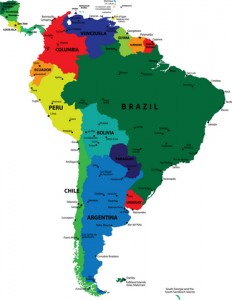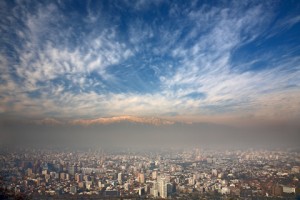
[Updated Oct 2020] A guide to serviced offices and office space for rent in Santiago as well as general information that may be useful if you are thinking of renting office space in the city.
For further offices information or to search for offices for rent in Santiago just click. Or contact us for any other office space query.
History & Geography
Located in Chile’s lush central valley, Santiago is surrounded by the Andes to the east and the Chilean Coastal Range to the west. The city is built on either side of the Mapocho River, which flows down from the Andes. Chile’s capital was founded in 1541 by the Spanish Conquistador Pedro de Valdivia who named the new settlement Santiago de la Nueva Extremadura. Valdivia chose Santiago mainly for its ease of defence and lush vegetation. This was to prove prudent as the first years of its existence saw Santiago under almost constant attack from the native Incans. However, despite the attacks, the city was settled successfully and grew rapidly in size with both a cathedral and church being built, as well as a bridge across the Mapocho River. In 1817 Chile proclaimed its independence and confirmed it a year later by decisively defeating Spanish Royalist forces at the Battle of Maipu. During the rest of the 19th century, Santiago continued to grow. The University of Chile was founded as well as the National Museum of Natural History. Additionally, the first telegraph system was built and the city became the hub of the new national railway service. The modernization continued in the early 20th century as the city industrialized and the population grew due to emigration from the country’s south. In 1962 Santiago hosted the World Cup, greatly accelerating the development of the city’s transport and civil infrastructure. Several years later Santiago opened Pudahuel Airport and soon after completed its metro system. In 1973 a coup took place and a military government was installed under General Augusto Pinochet. During his regime, all opposition was crushed and human rights abuses were carried out which saw 1,500 to 2,000 Chileans killed. Pinochet ceded power in 1990 and was indicted for human rights violations in 1998.
Pollution
Partly because of its geography, Santiago is one of the worst polluted cities in South America. A process called thermal inversion causes smog and air pollution to be trapped in the central valley during the winter months. The El Teniente copper mine is a major source of pollution year round. Additionally, the Mapocho River is completely contaminated by the copper mining waste dumped from upstream. Diesel trucks and buses also contribute to the lack of air quality, though are gradually being phased out.
Economy
Santiago functions as the manufacturing and financial centre of Chile. The city makes up a full 45 percent of Chile’s GDP and is a major regional administration centre. Among the staples of Santiago’s economy are leather technologies and food processing. Mining and textile and clothing production are also very important to the city. Computer technology and electronic industries have grown in Santiago of late, and HP, Intel, IBM, Microsoft and Yahoo all have offices in the city. All of Chile’s banks are headquartered in the city and many international financial services companies also have a presence in Santiago. Chile also has a sizable retail industry and the city is dotted with several major shopping centres and malls. In Santiago’s east side neighbourhoods many expensive boutique stores have operations, especially in Alonso de Cordova Street. Traditionally Santiago has had a fairly stable economy and is a popular investment area for American and South American investors. Santiago is also home to the Economic Commission for Latin America and the Caribbean which encourages economic cooperation between its member states.
 Tourism
Tourism
As one of the major capitals of South America Santiago is visited often by tourists. The city lacks much old architecture due to a combination of earthquakes and new construction efforts, however, there are still a few old buildings from the city’s colonial past to be seen. The Casa Colorada from 1769 and the Church San Francisco, from the 16th century are both popular sites, as is the Posada del Corrigador. The presidential palace, Palacio de la Moneda is one of the most impressive buildings in the city, featuring an ornate neoclassical façade. The changing of the guard ceremony every other day usually draws a crowd of tourists and onlookers. Santiago’s biggest green space is the Cerro San Cristobal which can be accessed by a cable car or funicular and offers a breathtaking view of the city on the days when the smog is not too thick. Chile is renowned for its wine and some of the best vineyards in the country are within striking distance of the city, specifically the Vina Cousino Macul, tours of which include the process of making the wine from picking the grapes to the finished bottle.
Transport
Santiago is served by the Comodoro Arturo Merino Benitez International Airport which is approximately 15 minutes by car from the city centre. Santiago’s central rail station, the Estacion Central, serves trains which connect Santiago to almost all of Chile’s major cities. Santiago itself has experienced major transportation problems in the past, mostly from its over-reliance on cars, resulting in gridlock. In 2007 a major new system was devised, with new bus routes and a contactless smartcard provided. The Santiago metro is also a popular way to travel with 89 stations and over 84 kilometres of tracks. Recently Santiago has tried to build more bicycle lanes in an attempt to encourage cycling. However, the lanes are not connected and progress has been slow.

Office space to rent in Santiago
Unlike the European and American economies, Chile was never unduly affected by the economic crisis. Currently, inflation is under control and unemployment is continually dropping. Santiago’s vacancy rate is at approximately 6 percent, a growth on previous years, mainly as a result of the delivery of new supply. Currently, the Las Condes neighbourhood is the most popular district for offices, and has by far the most supply, both existing and yet to be delivered. Currently, the average rental price is USD 26 per square metre per month.
We carry out a free office space search and our advisory and acquisition services are also free, always. Our Santiago office space brokers and agents are globally regulated by the Royal Institution of Chartered Surveyors (RICS) ensuring the highest standards of commercial property advice and service at all times. We look forward to helping you find the best office space for rent for your business.